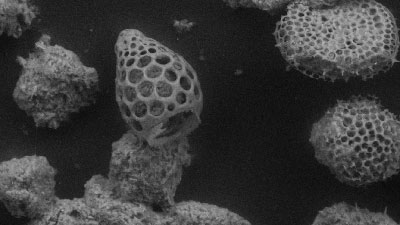Tiny worm pellets
Duration: 59 secs
Share this media item:
Embed this media item:
Embed this media item:
About this item

| Description: | Matthew Kuo tells us how tiny worm faecal pellets affect how oil pipelines sit on the seabed. |
|---|
| Created: | 2012-04-12 14:22 |
|---|---|
| Collection: | Under the Microscope |
| Publisher: | University of Cambridge |
| Copyright: | University of Cambridge |
| Language: | eng (English) |
| Keywords: | microscope; fossils; worm; pipeline; |
| Abstract: | Under the Microscope is a collection of videos that show glimpses of the natural and man-made world in stunning close-up. They are released every Monday and Thursday and you can see them here: www.io9.com/underthemicroscope
Matthew Kuo: “I have a research interest in the geotechnical behaviour and biological origin of deep ocean clay crusts. These crusts are found in many areas that are of particular importance to offshore oil and gas developments, including the Gulf of Guinea, Gulf of Mexico and the Mediterranean Sea. I have discovered that sediments from these areas contain millions of tiny faecal pellets that have been produced by burrowing invertebrates (worms). These pellets, whose abundance in the sediment may range from 30% to 60% by dry mass, are robust and much stronger than undigested material. Their presence and mechanical behaviour can therefore explain the existence of the observed crusts. This video shows several pellets that have partially degraded over time adjacent to microfossils. I have discovered that when hot-oil pipelines are laid onto these pelletised sediments, the rough pipeline coatings cause the pellets to disintegrate. This in turn causes a reduction in friction between the pipeline and the seabed. I am therefore investigating how we can better understand this complicated soil-pipeline interaction. This research will help predict longer-term hot-oil pipeline behaviour, leading to safer and more economical designs." The pellets shown in this image are about 50 micrometers in diameter. This is about the same diameter as a human hair Many thanks to Professor Malcolm Bolton, Mr Andy Hill, Ms Anne Bahnweg, Mr Alan Heaver. More info: http://www-geo.eng.cam.ac.uk/directory/myhk2@cam.ac.uk Department of Engineering http://www.eng.cam.ac.uk Music by Peter Nickalls http://www.peternickalls.com Find more Cambridge research here: http://www.cam.ac.uk/research |
|---|---|
Available Formats
| Format | Quality | Bitrate | Size | |||
|---|---|---|---|---|---|---|
| MPEG-4 Video | 640x360 | 1.85 Mbits/sec | 13.69 MB | View | Download | |
| WebM | 640x360 | 580.92 kbits/sec | 4.25 MB | View | Download | |
| iPod Video | 480x270 | 508.75 kbits/sec | 3.66 MB | View | Download | |
| MP3 | 44100 Hz | 126.28 kbits/sec | 915.58 kB | Listen | Download | |
| Auto * | (Allows browser to choose a format it supports) | |||||

